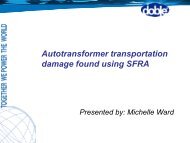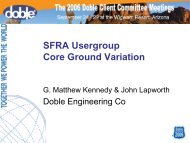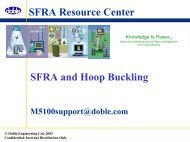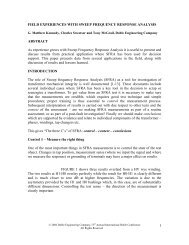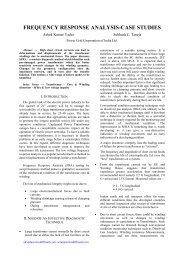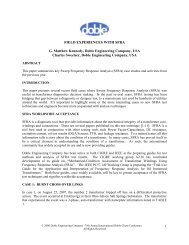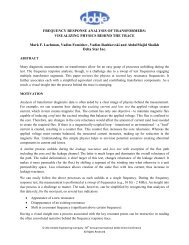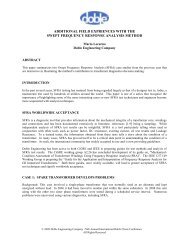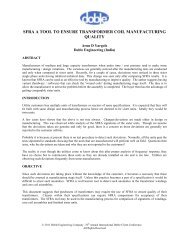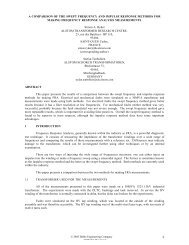Transformer Transportation Damage, A Case Presentation of a Low ...
Transformer Transportation Damage, A Case Presentation of a Low ...
Transformer Transportation Damage, A Case Presentation of a Low ...
You also want an ePaper? Increase the reach of your titles
YUMPU automatically turns print PDFs into web optimized ePapers that Google loves.
DERAILMENT EVENT<br />
<strong>Transportation</strong> <strong>of</strong> the 450 MVA transformer from the factory to the utility’s site required rail shipment given that the<br />
shipping weight was on the order <strong>of</strong> 500,000 lbs. While the transformer was being transferred in a railroad<br />
switching yard, the railcar became derailed. The railcar was traveling at a relatively low speed at the time <strong>of</strong> the<br />
derailment; the derailment event did not turn over the transformer or railcar. The impact recorder on the derailed<br />
railcar recorded the relatively low impacts <strong>of</strong> X: 0.5g, Y: 3.0g and Z: 0.5g. One rail twisted over on its side due to<br />
the weight <strong>of</strong> the transformer and railcar. It was reported that the transformer and railcar traveled the length <strong>of</strong> about<br />
one railcar on the rail ties, see Figure 1. It was believed that riding over the rail ties subjected the transformer to a<br />
short but significant vibration event due to the multiple low level impacts that it experienced [3].<br />
Derailment <strong>of</strong> <strong>Transformer</strong> Railcar during Shipment<br />
Figure 1<br />
There were some external signs <strong>of</strong> possible damage to the transformer but they were not significant. The paint on<br />
some tank end gusset welds had small hairline cracks indicating that the weld joint was overstressed. The paint at<br />
the bottom base plate braces was chipped <strong>of</strong>f indicating contact between the tank base and bracing members.<br />
Neither <strong>of</strong> these was proven to be due to the derailment event and they did not appear to be significant or to indicate<br />
other possible damage. The electrical acceptance testing performed on the transformer upon arrival at the utility’s<br />
site did not indicate any problems with the transformer. SFRA testing was performed and there were no major<br />
problems detected but the results were inconclusive since there was no reference test performed before shipment that<br />
could be used for comparison purposes.<br />
The manufacturer, at this point in time, did not believe that there was damage sustained to the transformer and did<br />
not recommend any further investigation <strong>of</strong> the incident; however, the purchaser arranged for an internal inspection<br />
<strong>of</strong> the transformer before accepting the unit.<br />
INTERNAL INSPECTION<br />
An internal inspection <strong>of</strong> the transformer was performed at the utility’s site before the transformer was removed<br />
from the railcar. The unit was opened up and a dry air supply connected to the tank to help reduce the exposure <strong>of</strong><br />
the cellulose insulation to moisture. The core and coils assembly and mechanical members were inspected. As is<br />
common with many transformers designed in recent years, the internal clearances were tight and limited access at<br />
times during the inspection.<br />
The internal inspection identified signs <strong>of</strong> overall movement <strong>of</strong> the core and coil assembly with respect to the tank.<br />
Tear marks in the pressboard isolation sheets used between the bottom <strong>of</strong> the core clamps and the tank bottom<br />
indicated longitudinal movement <strong>of</strong> the core and coils assembly relative to the tank, see Figure 2. The pressboard<br />
sheets were held in place with a steel locating pin welded to the tank bottom and a “guide rail” was located at the<br />
edge <strong>of</strong> the sheets. The sheets showed tear marks from the locating pins and “guide rails”, evidence that the core<br />
and coils assembly moved about 2 in. from end-to-end with respect to the tank base plate during shipment.<br />
© 2010 Doble Engineering Company -77 th Annual International Doble Client Conference<br />
All Rights Reserved<br />
2



